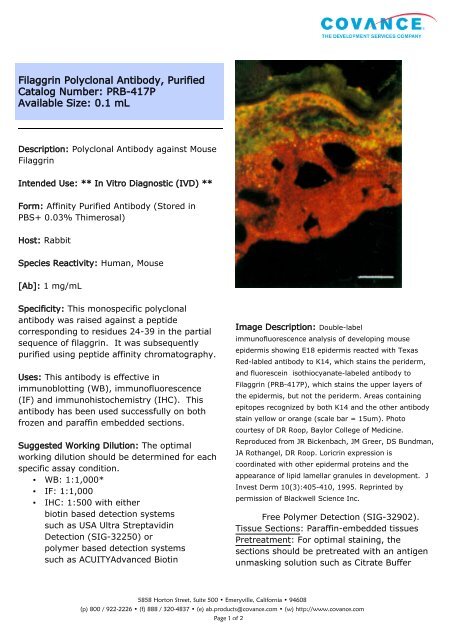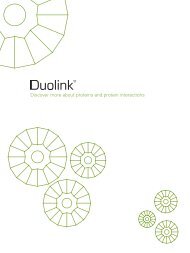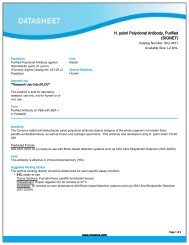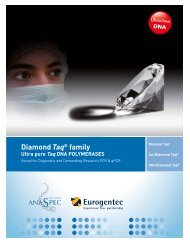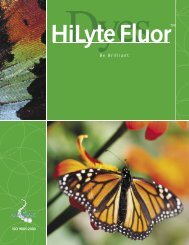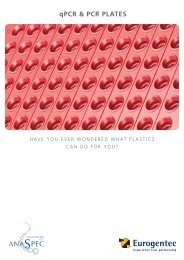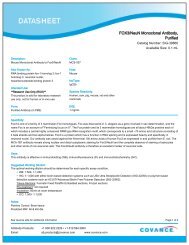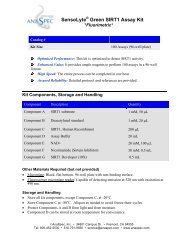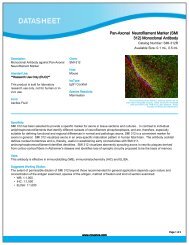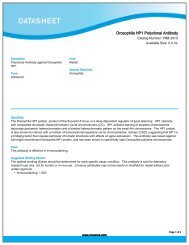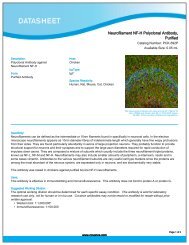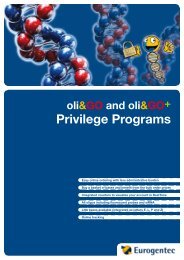Filaggrin Polyclonal Antibody, Purified Catalog ... - Eurogentec
Filaggrin Polyclonal Antibody, Purified Catalog ... - Eurogentec
Filaggrin Polyclonal Antibody, Purified Catalog ... - Eurogentec
You also want an ePaper? Increase the reach of your titles
YUMPU automatically turns print PDFs into web optimized ePapers that Google loves.
<strong>Filaggrin</strong> <strong>Polyclonal</strong> <strong>Antibody</strong>, <strong>Purified</strong><br />
<strong>Catalog</strong> Number: PRB-417P<br />
Available Size: 0.1 mL<br />
Description: <strong>Polyclonal</strong> <strong>Antibody</strong> against Mouse<br />
<strong>Filaggrin</strong><br />
Intended Use: ** In Vitro Diagnostic (IVD) **<br />
Form: Affinity <strong>Purified</strong> <strong>Antibody</strong> (Stored in<br />
PBS+ 0.03% Thimerosal)<br />
Host: Rabbit<br />
Species Reactivity: Human, Mouse<br />
[Ab]: 1 mg/mL<br />
Specificity: This monospecific polyclonal<br />
antibody was raised against a peptide<br />
corresponding to residues 24-39 in the partial<br />
sequence of filaggrin. It was subsequently<br />
purified using peptide affinity chromatography.<br />
Uses: This antibody is effective in<br />
immunoblotting (WB), immunofluorescence<br />
(IF) and immunohistochemistry (IHC). This<br />
antibody has been used successfully on both<br />
frozen and paraffin embedded sections.<br />
Suggested Working Dilution: The optimal<br />
working dilution should be determined for each<br />
specific assay condition.<br />
▪ WB: 1:1,000*<br />
▪ IF: 1:1,000<br />
▪ IHC: 1:500 with either<br />
biotin based detection systems<br />
such as USA Ultra Streptavidin<br />
Detection (SIG-32250) or<br />
polymer based detection systems<br />
such as ACUITYAdvanced Biotin<br />
5858 Horton Street, Suite 500 • Emeryville, California • 94608<br />
(p) 800 / 922-2226 • (f) 888 / 320-4837 • (e) ab.products@covance.com • (w) http://www.covance.com<br />
Page 1 of 2<br />
Image Description: Double-label<br />
immunofluorescence analysis of developing mouse<br />
epidermis showing E18 epidermis reacted with Texas<br />
Red-labled antibody to K14, which stains the periderm,<br />
and fluorescein isothiocyanate-labeled antibody to<br />
<strong>Filaggrin</strong> (PRB-417P), which stains the upper layers of<br />
the epidermis, but not the periderm. Areas containing<br />
epitopes recognized by both K14 and the other antibody<br />
stain yellow or orange (scale bar = 15um). Photo<br />
courtesy of DR Roop, Baylor College of Medicine.<br />
Reproduced from JR Bickenbach, JM Greer, DS Bundman,<br />
JA Rothangel, DR Roop. Loricrin expression is<br />
coordinated with other epidermal proteins and the<br />
appearance of lipid lamellar granules in development. J<br />
Invest Derm 10(3):405-410, 1995. Reprinted by<br />
permission of Blackwell Science Inc.<br />
Free Polymer Detection (SIG-32902).<br />
Tissue Sections: Paraffin-embedded tissues<br />
Pretreatment: For optimal staining, the<br />
sections should be pretreated with an antigen<br />
unmasking solution such as Citrate Buffer
Cont. of PRB-417P<br />
Retrieval solution (SIG-31932, SIG-31934).<br />
Incubation: 60 minutes at room temperature<br />
Notes: *Predicted MW = 27 kDa monomer in<br />
mouse, 40 kDa monomer in human. High MW<br />
smear usual due to extensive cross-linking in<br />
mature cells.<br />
Storage: When stored at ≤20°C, product is<br />
stable until the date shown on the label. Avoid<br />
repeated freeze-thaw cycles to prevent<br />
denaturing the antibody. If thawed and stored<br />
at 2-8°C, product is stable for 24 months from<br />
the date of thaw or until the expiry date on the<br />
label, whichever comes first.<br />
References: Hu Y, Baud V, Oga T, Kim KI,<br />
Yoshida K, Karin M. IKKalpha controls<br />
formation of the epidermis independently of<br />
NF-kappaB. Nature 410:710-714, 2001.<br />
Yuspa SH, Kilkenny AD, Steinert PM, Roop DR.<br />
Expression of murine epidermal differentiation<br />
markers is tightly regulated by restricted<br />
extracellular calcium concentrations in-vitro. J<br />
Cell Biol 109:1207-1217, 1989. [WB, IF]<br />
Roop DR, Cheng CK, Titterington L, Meyers CA,<br />
Stanley JR, Steinert PM, Yuspa SH. Synthetic<br />
peptides corresponding to keratin subunits<br />
elicit highly specific antibodies. J Biol Chem<br />
259:8037-8040, 1984. [General]<br />
Warranty/Conditions: Covance products may<br />
not be resold or modified for resale without<br />
prior written approval.<br />
Related Products:<br />
▪ Involucrin <strong>Polyclonal</strong> <strong>Antibody</strong><br />
<strong>Catalog</strong> Number PRB-140C<br />
▪ Loricrin <strong>Polyclonal</strong> <strong>Antibody</strong>, <strong>Purified</strong><br />
<strong>Catalog</strong> Number PRB-145P<br />
5858 Horton Street, Suite 500 • Emeryville, California • 94608<br />
(p) 800 / 922-2226 • (f) 888 / 320-4837 • (e) ab.products@covance.com • (w) http://www.covance.com<br />
Page 2 of 2<br />
▪ Pan-Cytokeratin (AE1/AE3) Monoclonal<br />
<strong>Antibody</strong>, <strong>Purified</strong> (SIGNET)<br />
<strong>Catalog</strong> Number SIG-3464<br />
▪ ACUITYAdvanced Biotin Free Polymer<br />
Detection System 50 Test DAB kit<br />
<strong>Catalog</strong> Number SIG-32902<br />
▪ Ultrastreptavidin (USA) Horseradish<br />
peroxidase (HRP) 50 Test, Multi-Species, DAB<br />
Detection Kit (SIGNET)<br />
<strong>Catalog</strong> Number SIG-32250<br />
▪ DAB Substrate Buffer with Stabilizer<br />
(SIGNET)<br />
<strong>Catalog</strong> Number SIG-31049<br />
▪ ACUITYAdvanced Mouse-on-Mouse Polymer<br />
Detection System 50 Test DAB kit<br />
<strong>Catalog</strong> Number SIG-32820<br />
▪ Sodium Citrate H.I.E.R., 1x (SIGNET)<br />
<strong>Catalog</strong> Number SIG-31932<br />
Product Revision Date: 9/18/2009


